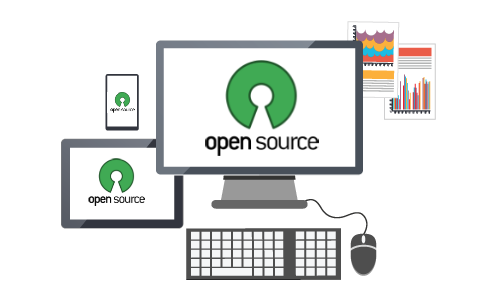Even if you’re not a computer programmer yourself, understanding the difference between closed and open source code is key to saving your business money.

And that’s as it should be. You’ve got projects to manage, a staff to supervise, a full calendar of tasks to plow through. If your software dependably helps you save effort and time, that’s a definite win.
But knowing a little bit about the difference between closed and open source solutions in software development can save money, too.
Sooner or later, your enterprise will need new software programs to sustain and accelerate its success. When that time comes, you’ll want to develop and deploy that software as cost-effectively as possible. Paying a little attention to code choices now can pay off then.
Closed Source and Open Source: What’s the Difference?
So what is open source?
Programmers write source code that, when translated into the “ons” and “offs” of machine language, “tells” a computer what to do. That source code can be closed or open.
Closed source software runs on proprietary code that is strictly guarded against modifications.
Open source software (or OSS) runs on code that is accessible, and that any programmer may modify.
This open source software definition may raise the question: If anyone can make changes, what’s to stop users from meddling with it so much that its quality and reliability suffer?
It’s a valid concern—in theory. But in practice, at least two factors work against that negative outcome.
First, some producers of open source code do still maintain some degree of control over who can make changes.
Second, and more importantly, keeping the code open to inspection, critique, correction, and refinement means it is going to become better code than it ever could if only a few sets of privileged eyes saw it.
Proponents of open source solutions will tell you the phrase itself connotes such values as transparency, collaboration, meritocracy, and community. The code that survives deserves to survive. It’s been vetted and tested by an incredibly large circle of knowledgeable users.
If you use the internet (and, since you’re reading this blog, we’ll assume you do!), then you see the benefits of OSS whenever you log on. As author Steven Johnson wrote in the New York Times in 2012, the net “was created by—and continues to be shaped by—decentralized groups of scientists and programmers and hobbyists (and more than a few entrepreneurs) freely sharing the fruits of their intellectual labor with the entire world.”
Open source solutions also shape modern business. A major survey last year (Black Duck and North Bridge’s “Future of Open Source” survey) found 78% of respondents’ businesses run part or all of their operations using OSS. It also found 66% of enterprises consider an open source approach first when developing software.
How Open Source Solutions Benefit the Bottom Line
Open source application development has become the business world’s go-to methodology in large part because of its potential to save businesses money. How? In at least three ways:
- Open source solutions save development costs – Barclays, the British bank, made headlines in 2013 when it announced that OSS had reduced its app development costs by 90%, saving it billions of pounds. Some said Barclay’s open source approach was a “snub” to major software vendors. But what business wouldn’t want to realize that level of savings? Because companies need not pay for proprietary code, they can customize their existing software far more, as well as develop entirely new apps (a once-fading option now making a comeback) for far less.
- Open source solutions save operating costs – The savings don’t stop once the software is developed. When OSS users need help, they can receive it any time, for free, because expert knowledge and documentation about the software is freely available online. In addition, users can be done with the mandatory, paid upgrades much proprietary software requires to continue using it. Plugins and addons for OSS also tend to be free or offered at much lower fees than major software vendors charge.
- Open source solutions save money by making businesses more agile – Because companies that use OSS solutions don’t have to wait for software vendors to make desired, even necessary, changes to their products, these enterprises possess a competitive edge in meeting the marketplace’s changing conditions. They can instead simply find a piece of OSS that does what they need done and deploy it right away, which means they can start making more money right away.
An Open Source Solutions Partnership With Evoke
We at Evoke Technologies bring more than a decade’s experience as an IT leader to the design and implementation of OSS solutions for commercial enterprises. Our dedicated open source experts will learn your company’s most pressing challenges and guide you in developing an OSS plan to meet them. Whether e-commerce, customer relations or content management, quality assurance or more, Evoke has open source expertise to benefit your business.
Contact Evoke Technologies at (937) 202-4161, and learn how we, as your open source solution provider, can start making your company’s software development and operations budget go farther today!
Related Tags: Open Source Solutions | Evoke Technologies






